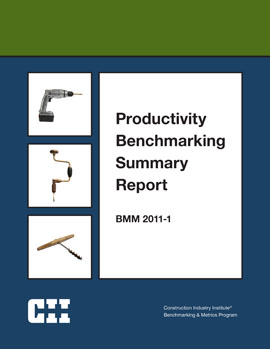
Productivity Benchmarking Summary Report
Increasing global competition and the diminishing pool of skilled construction craft workers have put unprecedented pressure on the U.S. construction industry to effectively use its resources and workforce. Productivity measurements capture how well resources—particularly, human resources—are used to produce outputs. Benchmarking productivity provides a reliable basis for self-analysis and improvement. In order to estimate and control project costs, many engineering and construction organizations have developed internal systems to measure and report productivity; however, few creditable data sources exist by which these organizations can compare their own productivity to that of their peers. Moreover, even today, different organizations use different metrics to measure engineering and construction productivity.
Over the past two decades, the Construction Industry Institute (CII) has launched a number of research teams, with members from both industry and academia, to examine engineering and construction productivity. Much of this research has suggested that the measurement of productivity should focus on those labor-intensive activities that have the greatest impact on project cost and schedule. Some of the early CII research studied the impact of scheduled overtime and change orders on labor productivity (CII 1994a, CII 1994b). Research Team (RT) 143 examined two strategies to improve construction productivity (CII 2001a). One of these strategies, the buffer strategy, provides large stockpiles of design, materials, and equipment; the other strategy, the production planning strategy, carefully plans and delivers all necessary productive resources to the workers. Recently, RT 215 studied the factors affecting labor productivity from the craft workers’ perspective (CII 2006). Meanwhile, RT 156 proposed and validated the concept of measuring engineering productivity on the basis of issue-for-construction (IFC) quantities rather than intermediate deliverables, such as drawings and specifications (CII 2001b). Taking RT 156’s quantity-based approach, RT 192 developed a model that predicts engineering work hours by using actual design quantities at the engineering discipline level (CII 2004). The ratio of actual engineering hours to engineering basis hours represents the engineering discipline productivity index of a specific project. However, RT 192 also concluded that engineering hours cannot be reported below the discipline level because of the difficulty of data collection for individual engineered items.
Because many CII members believed that, in order to understand the factors that affect productivity, there must first be an effort to track it; they concluded that productivity benchmarking would better drive work process improvement than would the traditional tracking of cost and schedule. Therefore, in 2000, CII Benchmarking & Metrics (BM&M) initiated Productivity Benchmarking, a program that uses IFC-quantity-based metrics. Over the following few years, a series of workshops and meetings was held to establish an industry consensus on productivity metrics and definitions. Since then, the CII BM&M Committee has held many training sessions to promote productivity metrics and to obtain feedback on the productivity benchmarking program. CII has also developed an online system to allow productivity benchmarking participants to enter their data and access aggregated productivity data through the CII website. Since 2002, the program has collected data from over 200 projects. Now by benchmarking productivity with CII, project management teams can not only identify gaps in their productivity, but they can also find the possible causes of their productivity loss.
This report provides an overview of the current productivity benchmarking program. Chapter Two presents the framework of CII productivity benchmarking. Specifically, it explains what CII measures regarding engineering and construction productivity and how it is measured. Chapter Three describes the outputs of productivity benchmarking, including the project key report and the data report. Chapter Four summarizes some of the preliminary analyses on the current database. Finally, Chapter Five discusses the value the CII productivity benchmarking efforts provide to participating organizations.
{^widget|(widget_displayname)WatermarkImage|(name)WatermarkImage|(image)%7e%2fCII%2fmedia%2fPublications%2fBMM2011_1Figure19.PNG%3fext%3d.png|(width)|(height)^}


